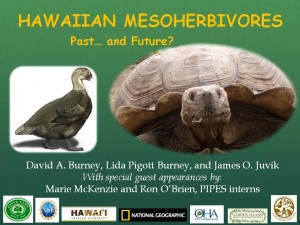Tortoise Project Races On
August 29, 2012
With the slow and steady progress of the tortoises themselves, our project to enlist the help of now eight reptilian volunteers plods on with remarkable results. Our tortoises continue to do major weeding service inside their securely fenced paddocks at Makauwahi Cave Reserve. They have also created quite a buzz throughout the conservation community here in the islands – and well beyond.
Our first major article on the use of tortoises to control invasive weeds in Hawaiian native plant restorations came out last week, in the new, lavishly illustrated flagship journal of the Turtle Conservancy, The Tortoise. 
Entitled “Can Unwanted Suburban Tortoises Rescue Native Hawaiian Plants?” the article can be downloaded here along with information on how to obtain the entire beautiful magazine and support the Turtle Conservancy’s many conservation projects worldwide.
In the article, we trace the history of the Sulcata tortoise in the U.S. pet trade, its continuing survival challenge in its native range in sub-Saharan Africa due to habitat loss and poaching, and the story of how co-author Prof. James Juvik helped introduce the species to American turtle fanciers 40 years ago and now is helping to find “employment” for people’s overgrown pets, which may live a century or more. We present the first preliminary results from our behavioral studies and feeding trials, which confirm their remarkable preference for eating our most hated weeds, and trace the coevolutionary connection between tortoises, giant flightless herbivorous birds, and island plants, focusing on scientists’ newfound realization that plants of remote islands may have defensive strategies against “toothless mesoherbivores.”
Meanwhile, we gave a presentation at the Hawaii Conservation Conference in Honolulu August 1, to a large audience, entitled “Hawaiian Mesoherbivores, Past and Future.” Two of our summer interns, Ron O`Brien and Marie Maile McKenzie, supported by the PIPES program at UH-Hilo and the Invasive Species Strike Team of the US Fish & Wildlife Service, attended the conference and presented their exciting results from the experiments they carried out this summer with our tortoises. Key findings: in a huge sample of tortoise behavior, including 310 field observations of feeding behavior, our tortoises ate invasive non-native weeds 93.5% of the time. Of the small number of native plants they ate, nearly every instance was a leaf or fruit that had already dropped on the ground. Their germination experiments suggest they enhance the sprouting of seeds they ingest. Soils inside the tortoise paddocks showed much higher concentrations of primary nutrients than soils just outside, showing the beneficial effect of their dung on the soils around our native plants.
After the talk and during the rest of the conference, conservationists from state, federal, and non-governmental organizations had many very positive questions and comments about the presentation. The most common remark, heard many times during the conference, was “Where can we get some tortoises to try in our restorations?” For the answer, read our article!